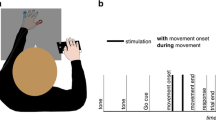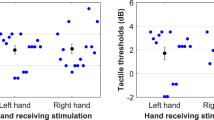Abstract
This study addressed the paradoxical observation that movement is essential for tactile exploration, and yet is accompanied by movement-related gating or suppression of tactile detection. Knowing that tactile gating covaries with the speed of movement (faster movements, more gating), we hypothesized that there would be no tactile gating at slower speeds of movement, corresponding to speeds commonly used during tactile exploration (<200 mm/s). Subjects (n = 21) detected the presence or absence of a weak electrical stimulus applied to the skin of the right middle finger during two conditions: rest and active elbow extension. Movement speed was systematically varied from 50 to ~1,000 mm/s. No subject showed evidence of tactile gating at the slowest speed tested, 50 mm/s (rest versus movement), but all subjects showed decreased detection at one or more higher speeds. For each subject, we calculated the critical speed, corresponding to the speed at which detection fell to 0.5 (chance). The mean critical speed was 472 mm/s and >200 mm/s in almost all subjects (19/21). This result is consistent with our hypothesis that subjects optimize the speed of movement during tactile exploration to avoid speeds associated with tactile gating. This strategy thus maximizes the quality of the tactile feedback generated during tactile search and improves perception.






Similar content being viewed by others
References
Angel RW, Malenka RC (1982) Velocity-dependent suppression of cutaneous sensitivity during movement. Exp Neurol 77:266–274
Bays PM, Wolpert DM, Flanagan JR (2005) Perception of the consequences of self-action is temporally tuned and event driven. Curr Biol 15:1125–1128
Bays PM, Flanagan JR, Wolpert DM (2006) Attenuation of self-generated tactile sensations is predictive, not post-dictive. PloS Biol 4:281–284
Chapman CE (1994) Active versus passive touch: factors influencing the transmission of somatosensory signals to primary somatosensory cortex. Can J Physiol Pharmacol 72:558–570
Chapman CE (1998) Constancy in the somatosensory system: central neural mechanisms underlying the appreciation of texture during active touch. In: Morley JW (ed) Neural aspects of tactile sensation (advances in psychology). Elsevier, Amsterdam, pp 275–298
Chapman CE (2009a) Active touch. In: Binder MD, Hirokawa N, Windhorst U (eds); Iwamura Y (Section editor) Encyclopedic reference of neuroscience. Springer, Heidelberg, pp 35–41
Chapman CE (2009b) Tactile attention. In: Binder MD, Hirokawa N, Windhorst U (eds); Iwamura Y (Section editor) Encyclopedia of neuroscience. Springer, Heidelberg, pp 3992–3995
Chapman CE, Beauchamp E (2006) Differential controls over tactile detection in humans by motor commands and peripheral reafference. J Neurophysiol 96:1664–1675
Chapman CE, Bushnell MC, Miron D, Duncan GH, Lund JP (1987) Sensory perception during movement in man. Exp Brain Res 68:516–524
Chapman CE, Jiang W, Lamarre Y (1988) Modulation of lemniscal input during conditioned arm movements in the monkey. Exp Brain Res 72:316–334
Chapman CE, Tremblay F, Ageranioti-Belanger SA (1996a) Role of primary somatosensory cortex in active and passive touch. In: Wing A, Flanagan R, Haggard P (eds) Hand and brain: neurophysiology and psychology of hand movement. Academic Press Inc., San Diego, pp 329–347
Chapman CE, Zompa IC, Williams SR, Shenasa J, Jiang W (1996b) Factors influencing the perception of tactile stimuli during movement. In: Franzén O, Johansson R, Terenius L (eds) Somesthesis and the neurobiology of the somatosensory cortex. Birkhäuser Verlag, Basel, pp 307–320
Churchland MM, Shenoy KV (2007) Temporal complexity and heterogeneity of single-neuron activity in premotor and motor cortex. J Neurophysiol 97:4235–4257
Coquery JM, Malcuit G, Coulmance M (1971) Altérations de la perception d’un stimulus somesthésique durant un mouvement volontaire. C R Soc Biol (Paris) 165:1946–1951
Coulter JD (1974) Sensory transmission through lemniscal pathway during voluntary movement in the cat. J Neurophysiol 37:832–845
Driver J, Spence C (1998) Crossmodal links in spatial attention. Phil Trans R Soc B Biol Sci 353:1319–1331
Essick GK, Whitsel BL (1985) Factors influencing cutaneous directional sensitivity: a correlative psychophysical and neurophysiological investigation. Brain Res Rev 10:213–230
Ghez C, Lenzi GL (1971) Modulation of sensory transmission in cat lemniscal system during voluntary movement. Pflügers Arch 323:273–278
Grunwald AP (1966) A Braille-reading machine. Science 154:144–146
Jiang W, Chapman CE, Lamarre Y (1990) Modulation of somatosensory evoked responses in the primary somatosensory cortex produced by intracortical microstimulation of the motor cortex in the monkey. Exp Brain Res 80:333–344
Legge GE, Madison CM, Mansfield JS (1999) Measuring Braille reading speed with the MNREAD test. Vis Impairment Res 1:131–145
Matthews PBC (1981) Evolving views on the internal operation and functional role of the muscle spindle. J Physiol (Lond) 320:1–30
Morley JW, Goodwin AW, Darian-Smith I (1983) Tactile discrimination of gratings. Exp Brain Res 49:291–299
Post LJ, Chapman CE (1991) The influence of cross-modal manipulations of attention on the detection of vibrotactile stimuli in humans. Somatosens Motor Res 8:149–157
Post LJ, Zompa IC, Chapman CE (1994) Perception of vibrotactile stimuli during motor activity in human subjects. Exp Brain Res 100:107–120
Schmidt RF, Schady WJ, Torebjörk HE (1990) Gating of tactile input from the hand. I. Effects of finger movement. Exp Brain Res 79:97–102
Seki K, Perlmutter SI, Fetz EE (2003) Sensory input to primate spinal cord is presynaptically inhibited during voluntary movement. Nature Neurosci 6:1309–1316
Smith AM, Chapman CE, Deslandes M, Langlais J-S, Thibodeau M-P (2002a) The role of friction and tangential force in the subjective scaling of tactile roughness. Exp Brain Res 144:211–223
Smith AM, Gosselin G, Houde B (2002b) Deployment of fingertip forces in tactile exploration. Exp Brain Res 147:209–218
Smith AM, Chapman CE, Donati F, Fortier-Poisson P, Hayward V (2009) Perception of simulated local shapes using active and passive touch. J Neurophysiol 102:3519–3529
Wetherhill GB, Levitt H (1965) Sequential estimation of points on a psychometric function. Br J Math Stat Psychol 18:1–10
Williams SR, Chapman CE (2000) Time-course and magnitude of movement-related gating of tactile detection in humans II. Effects of stimulus intensity. J Neurophysiol 84:863–875
Williams SR, Chapman CE (2002) Time-course and magnitude of movement-related gating of tactile detection in humans III. Effects of motor tasks. J Neurophysiol 88:1968–1979
Williams SR, Shenasa J, Chapman CE (1998) Time-course and magnitude of movement-related gating of tactile detection in humans I. Importance of stimulus location. J Neurophysiol 79:947–963
Acknowledgments
The authors would like to thank the following for providing excellent technical assistance: R. Albert, the late R. Bouchoux, M. Bourdeau, and C. Valiquette. We thank Dr. Trevor Drew for his helpful comments on the manuscript. The research was supported by an operating grant from the Natural Sciences and Engineering Research Council of Canada (253438) and operating (MOP—14454) and Group grants from the Canadian Institutes of Health Research, and the Université de Montréal, as well as an infrastructure grant from the Fonds de la recherche en santé du Québec. Dr. Anita Cybulska-Klosowicz was supported by the H. Jasper fellowship from the Groupe de recherche sur le système nerveux central (GRSNC). Mélissa Raby was supported by a bursary from the Department of Physiology. Marie-Line Lemieux was supported by a bursary from the Faculty of Medicine (COPSE).
Author information
Authors and Affiliations
Corresponding author
Rights and permissions
About this article
Cite this article
Cybulska-Klosowicz, A., Meftah, EM., Raby, M. et al. A critical speed for gating of tactile detection during voluntary movement. Exp Brain Res 210, 291–301 (2011). https://doi.org/10.1007/s00221-011-2632-0
Received:
Accepted:
Published:
Issue Date:
DOI: https://doi.org/10.1007/s00221-011-2632-0




